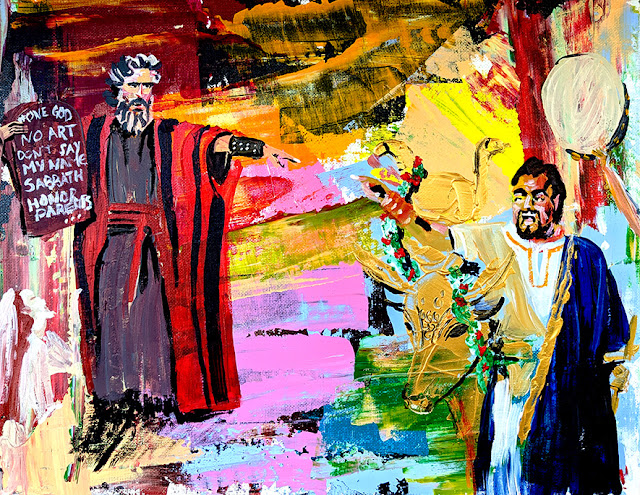Word vs. Image. The earliest forms of writing were cunieform in Mesopotamia and hieroglyphs in Egypt. In Mesopotamia, the creation of cunieform was credited to the Goddess Nisaba. In Egypt, Seshat was the Goddess of scribes, and created hieroglyphs. Both cunieform and hieroglyphs took time to learn. They each contained hundreds of symbols and were mostly studied by "the literary elite". They were based on images.
In between Egypt and Mesopotamia, scripts surfaced that were hybrids of the two forms. The peoples who lived between Egypt and Mesopotamia included Midianites, semi-nomadic camel caravaneers, Serite miners working copper quarries, Phoenician sea traders, and Canaanites with their terraced vineyards and olive groves. To the north was the land of the Assyrians, and to the south stood the fabled city of Jericho. Leonard Shlain, in The Alphabet Vs. The Goddess writes, "Wandering throughout these lands were groups of herders seeking pastures for their goats and sheep. These people are referred to in both ancient Mesopotamian and Egyptian texts as Habiru which means 'dusty travelers'. The similarity between 'Habiru' and 'Hebrew' has led many scholars to speculate that these Habiru may have been the precursors of the Israelites."
Shlain goes on, "In the first two millenia after the founding of Egypt and Mesopotamia, the patchwork quilt of clans inhabiting this region never came close to achieveing the grandeur, sophistication, or prosperity of their two powerful neighbors...[they] would have sunk into obscurity except for one stunning discovery. Someone, or some group among them, invented a greatly simplified method of written communication that shifted the perceptual mode by which people understood their reality, deflected the thrust of gender politics, and changed the course of history. This new scrivening was the alphabet."
An alphabet is by definition any form of writing that contains fewer than thirty signs. Alphabets represent words phonetically, unlike their predecessors, which used pictograms for words or syllables. This new alphabet was much easier to master and literacy could become more widespread. Shlain writes, "The religions that henceforth spiraled outward from unwinding reams of written scrolls demanded that acolytes be literate. Until that time, to know the deity one had only to see Her image or observe Her rituals. With the advent of the alphabet, to know the deity demanded that one must first read His written words."
"Despite the power of the empires that stood behind them, the two pillars of ancient literacy, cuneiform and hieroglyphics, eventually crumbled and were buried by the blowing sands of antiquity. Where once they had towered, the humble, vigorous, people's alphabet emerged. Over time, the cultures taking advantage of this new writing tool glorified monotheism, used the Rule by Law to reorganize society, invented money,...abused nature, glorified war, perfected imperialism, and held deep-seated sexist attitudes."
We can see this transition in the 1956 movie, the Ten Commandments. I've made a painting based on the scene in the movie that was most memorable to me. It's been years since I've seen it, but it has stuck in my mind.
Charleton Heston is the star of the Ten Commandments. He was chosen because of his resemblance to a Michelango sculpture of Moses. As Moses, he comes down off the mountain with his tablets. He has spoken with the new #1 diety who says, I'm #1, no more art, don't say my name, and some other stuff. (The Ten Commandments).
Charleton / Moses pops into the middle of a party. An artist has created a sweet sculpture. It's been adorned with flower wreaths. The female drummers are being carried on high, exuberantly dancing and playing. Everyone is joyful. The community is at peace. Everyone wears colors.
Charleton / Moses says, STOP. No more art. Only written words. There's a new #1 God and he does not like to party. At Moses's feet is a supplicating woman, wearing a veil and an ugly beige garment and weeping.
Yes... technically the commandments also say do not kill, but that's not until the second tablet. That's one's not even visible in the scene.
Of course all the artistic, musical party people are slain.
Hello Abrahamic religion.
Leonard Shlain hypothesizes in The Alphabet Versus The Goddess that the Hebrews actually invented the alphabet. The Torah / Old Testament is the earliest existing book originally written in a phonetic alphabet. The wars mentioned in it are the first wars we know of fought primarily for religious reasons. This is the first time images are banned. This is the real beginning of widespread patriarchy. Dr. Shlain hypothesizes that the creation of the alphabet and the spreading of literacy catalyzed these changes by rewiring our brains. His book is fascinating.
The Ten Commandments is also a crazy movie.

Comments
Post a Comment